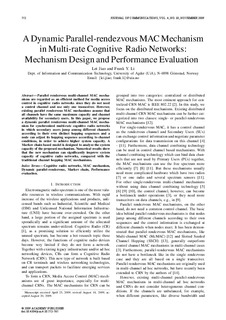| dc.contributor.author | Jiao, Lei | |
| dc.contributor.author | Li, Frank Yong | |
| dc.date.accessioned | 2010-02-18T09:15:00Z | |
| dc.date.issued | 2009 | |
| dc.identifier.citation | Jiao, L., & Li, F. Y. (2009). A dynamic parallel-rendezvous MAC mechanism in multi-rate cognitive radio networks: Mechanism design and performance evaluation. Journal of Communications, 4(10), 752-765. doi: 10.4304/jcm.4.10.752-765 | en |
| dc.identifier.issn | 1796-2021 | |
| dc.identifier.uri | http://hdl.handle.net/11250/137733 | |
| dc.description | Published version of an article published in the journal:Journal of Communications, © Academy Publisher
Also available from publisher:
http://dx.doi.org/10.4304/jcm.4.10.752-765 | en |
| dc.description.abstract | Parallel rendezvous multi-channel MAC mechanisms
are regarded as an efficient method for media access
control in cognitive radio networks since they do not need
a control channel and use only one transceiver. However,
existing parallel rendezvous MAC mechanisms assume that
all channels have the same maximum capacity and channel
availability for secondary users. In this paper, we propose
a dynamic parallel rendezvous multi-channel MAC mechanism
for synchronized multi-rate cognitive radio networks
in which secondary users jump among different channels
according to their own distinct hopping sequences and a
node can adjust its hopping sequence according to channel
conditions, in order to achieve higher system capacity. A
Markov chain based model is designed to analyze the system
capacity of the proposed mechanism. Numerical results show
that the new mechanism can significantly improve system
capacity of cognitive radio networks, compared with the
traditional channel hopping MAC mechanisms. | en |
| dc.format.extent | 507418 bytes | |
| dc.format.mimetype | application/pdf | |
| dc.language.iso | eng | en |
| dc.publisher | Academy Publisher | en |
| dc.title | A dynamic parallel-rendezvous MAC mechanism in multi-rate cognitive radio networks: Mechanism design and performance evaluation | en |
| dc.type | Journal article | en |
| dc.type | Peer reviewed | en |
| dc.subject.nsi | VDP::Technology: 500::Information and communication technology: 550 | en |
| dc.source.pagenumber | 752-765 | en |
| dc.source.volume | 4 | en |
| dc.source.journal | Journal of Communications | en |
| dc.source.issue | 10 | en |
